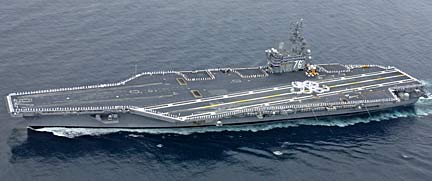
The Navy aircraft carrier USS Ronald Reagan, shown here entering San Diego, arrived at Pearl Harbor yesterday for a stopover before going to South Asia to assist in the earthquake and tsunami relief effort.
USS Reagan
makes stop in isles
The aircraft carrier docks in
Pearl Harbor before giving
aid to tsunami-hit nations
|
With a superstructure 20 stories above the waterline, USS Reagan made its first Pearl Harbor port call yesterday morning.
However, except for a few supply aircraft and helicopters, the Reagan docked minus its airwing of nearly six dozen F/A-18 Hornets, S-3B Vikings, EA-6B Prowlers, E-2C Hawkeyes, and SH-60 Sea Hawk, and other helicopters. This means there are about 2,500 fewer sailors and aviators that a nuclear carrier like the Reagan would normally carry.
Its contribution to the tsunami relief effort -- two Fleet Logistics Support Squadron (VRC) 30 C-2A Greyhound aircraft (known as CODs by Navy personnel) -- was dropped off at Pearl Harbor yesterday. CODs (carrier onboard delivery aircraft) provide logistics support to carrier strike groups by delivering supplies, mail and personnel to and from aircraft carriers at sea.
"CODs don't have the range or fuel to get from California to Hawaii on their own," said Lt. Cmdr. Jonathan Sweeten, Reagan assistant strike operations officer in a Navy news release. "So we'll be their floating platform to Hawaii, and from there, they'll be able to reach their destination."
The Navy isn't saying from where the two Reagan cargo planes will be operating or whether it will be flying off the carrier USS Abraham Lincoln, but each aircraft has a range of nearly 1,400 miles. Each plane can carry 10,000 pounds of cargo or 26 passengers.
The Reagan left San Diego on Jan. 11 for routine carrier operations.
However, on Tuesday Petty Officer 1st Class Benjamin J. Farrell, 26, of Maplewood, Minn., was disassembling a valve in the steam plant when he was burned by scalding hot water.
The carrier reversed its course -- delaying its first port call at Pearl Harbor by about a week -- after the accident.
Farrell was then put aboard a COD that took him to San Diego for medical care, but he died en route, Navy officials said.
The Reagan was supposed to have spent much of its time off San Clemente Island in Southern California waters to test the ship's self-defense system with live drones when it was diverted to Hawaii. A Navy nuclear power mobile training team also was scheduled to come aboard to train with the reactor department.
The Reagan was expected to spend four days in Pearl Harbor before returning to San Diego on Tuesday.
The Reagan was christened on March 4, 2001, by Nancy Reagan and arrived at its home port in San Diego on July 23.
Petty Officer Sean Jones, an aviation technician, welcomed the diversion and the short mission to aid the Asian countries hit by the Dec. 26 tsunamis.
"I think it's wonderful that we're able to take part in the relief over there," said Jones in a Navy release. "Asia got hit pretty hard, and they need all the help they can get."
"I'm not worried about staying out a few extra days," said Petty Officer Reid Ferrero, an aviation ordnance specialist. "If I can't see my wife for a couple more days, it's nothing compared to the people that have lost their loved ones in the tsunami."
Seventy-six aircraft carriers have been commissioned by the U.S. Navy. Of the 12 in service, 10 are nuclear-powered.
The USS George H.W. Bush, named for the 41st president, is under construction and expected to be commissioned in 2008.
ewcupdates.eastwestcenter.org/tsunamirelief/
American Red Cross Hawaii
www.hawaiiredcross.org/
Red Cross survivor locator
www.familylinks.icrc.org
Pacific Tsunami Warning Center
www.prh.noaa.gov/ptwc/
U.S. Pacific Command
www.pacom.mil/
[News] [Business] [Features] [Sports] [Editorial] [Do It Electric!]
[Classified Ads] [Search] [Subscribe] [Info] [Letter to Editor]
[Feedback]
